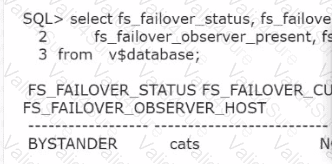1z0-076 Exam Dumps - Oracle Database 19c: Data Guard Administration
Your Data Guard environment has a remote physical standby database with real-time query enabled, which is used for reporting, and a logical standby database used for DSS reporting.
Switchovers or failovers are possible due to testing or in case of a disaster.
Clients use local TNSNAMES.ORA files to define connection strings to the database instances.
Which three will prevent clients from connecting to the wrong database instances?
In Oracle Database 19c, you can set the value of database initialization parameters in a database using
the EDIT DATABASE... SET PARAMETER Command:
DGMGRL> EDIT DATABASE 'boston' SET PARAMETER log_archive_trace - 1;
Which THREE statements are TRUE about the command?
Your expertise is requested for these customer requirements:
The Data Guard environment must be in maximum protection mode.
Reports must be offloaded to a physical standby database.
There must be no lag between the primary and standby databases that affect the reports produced.
The primary database must be resilient in case of a single network failure.
Which solution is correct for these requirements?
Which two statements are true regarding Data Guard environments in an Oracle Muti-tenant architecture?
Examine the Data Guard configuration:
DGMGRL> show configuration;
Configuration - Animals
Protection Mode: MaxAvailability
Databases:
dogs - Primary database
sheep - Snapshot standby database
cats - Physical standby database
Fast-Start Failover: DISABLED
Configuration Status:
SUCCESS
You receive an error while attempting to raise the protection mode to Maximum Protection:
DGMGRL> edit configuration set protection mode as maxprotection;
Error: ORA-16627: operation disallowed since no standby databases would remain to support protection mode
Failed.
Which is the minimum statement, or sequence of statements you must execute to enable successful raising of the protection mode to Maximum Protection?
Which two statements are true when using non-rolling release upgrades in a Data Guard environment?
